General lighting in the bedroom and hallway is not able to fully illuminate the lady's face for applying high-quality makeup. The mirror light will help you see the reflection in detail, apply makeup naturally and choose the perfect wardrobe for the day or evening event.
The main types and functions of the backlight
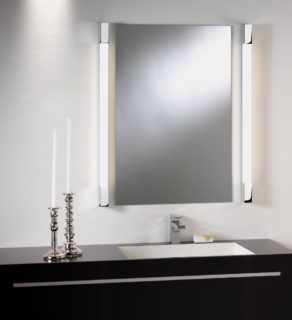
Mirror illumination is designed for uniform natural illumination of a person's silhouette, elimination of shadow effects that hide makeup defects, imperfections in clothing. Also, the backlight serves as a decoration for the interior of the room.
The following types of lights are installed on the mirrors:
- The external layout is equipped with lamps located around the perimeter on the body, frame or wall.
- The built-in illumination is equipped with the installation of LED strips under the glass along the perimeter of the outer edge of the canvas, removing part of the reflective coating.
- Decorative lighting is used for the stylistic, original design of the room.
Decorative lighting was singled out as a separate type for the task of design decoration being performed. Its layout can also be built-in and external.
Features and Benefits
Lighting fixtures produce bright, diffused light, directing it not to the surface of the mirror, but to the space in front of it. The number and location of light sources are determined, taking into account the characteristics of the room and the purpose of the mirror.
The use of localized mirror illumination has the following advantages:
- Light elements are distributed around the perimeter of the reflective canvas, illuminating the space in front of it evenly.
- Strict directionality of light sources eliminates glare.
- The lamps add up the luminous flux and produce a bright light.
- Lighting fixtures with natural color rendering provide an analogue of daylight.
- Matt diffusers eliminate glare.
The backlit mirror does not distort the reflection with shadows, unnatural shades, but shows the real appearance of a person.
Lamp types
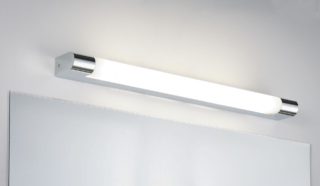
The type of light sources for illumination determines its reliability, functionality, and efficiency. The dimensions of the lighting fixtures are important for the design of the room.
Mirror illumination is made from the following types of light sources:
- Incandescent lamps have an affordable price, a large selection of sizes, capacities, but a short service life. The light from such sources has a reddish tint, which does not provide natural illumination, distorting the real image of a person in reflection. Large values of energy consumption and operating temperatures lead to the inapplicability of such lamps for illuminating mirrors.
- Halogen lamps have a more natural glow, but are not economical. They heat up to 500 ℃, which leads to premature failures.
- Luminescent sources have a natural spectrum, economical energy consumption, and a long service life. Linear lamps and compact fluorescent lamps are used for outdoor illumination, since their dimensions limit the possibility of embedding into the mirror housing.
- Neon tubes are used for colored decoration. The peak of the popularity of neon was in the eighties of the last century. The advent of inexpensive, convenient semiconductor lighting sources has led to a decline in the demand for neon.
- LED strips and lamps are more economical and durable than fluorescent fixtures. LED sources are environmentally friendly, safe for health, create bright lighting with a color rendering close to the solar spectrum. The compact dimensions of the LED strips allow the manufacture of built-in mirror illumination.
LED lamps do not heat up during operation, which allows them to be used to illuminate make-up mirrors.
LED lighting fixtures
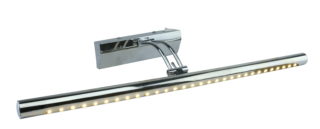
The use of ready-made LED lamps is gaining popularity in various areas of everyday life. A variety of shapes, sizes, modifications provides space for designers' creativity.
They use overhead, recessed, hinged LED lamps for mirrors. In the absence of electrical wiring, they use stand-alone models that run on batteries. Skilled craftsmen independently make various backlighting options from LED elements.
Color shades of lamps
Illumination sources are characterized by a color rendering that overlays the tint of a specific color range. In everyday life, lamps with cold, white, warm spectra are used.
Cold light creates crisp, detailed reflections, but tiring of the eyes. The warm light is pleasing to the eye, creates a cozy atmosphere, but distorts the color of the reflection with red tints. The balanced white light allows for natural lighting of the face, creating a real reflection.
Accommodation options
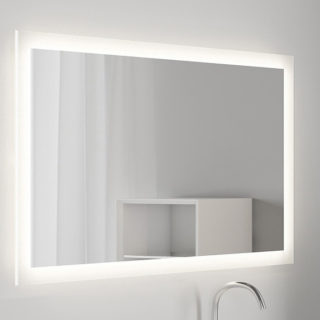
The location of the light sources affects the uniformity of the illumination. Lamps for outdoor lighting are placed on the sides of the canvas, above, below or along the perimeter of the frame. The installation of lamps around the perimeter is used for makeup mirrors, since such an arrangement allows you to illuminate in detail all areas of the face.
Illumination of tall mirrors of hallways, corridors is made from six or more sources, evenly distributed along the sides. Fewer sources do not provide bright height illumination.
Built-in backlighting is made of LED strips, which are mounted on the back of the canvas along the edge of the perimeter. The reflective coating is removed from the LED installation line, the resulting transparent windows are covered with a matte film.
For decorative lighting equipment, white and colored RGB LED strips are used, which are embedded under a reflective canvas or fixed from the outside on a frame or glass. Popular 3D designs of two parallel reflectors with an LED strip located along the contour between them.
Switch types
The lamps are powered from a 220 V network, and the LED strips are powered by a constant voltage of 12 V, generated by an additional power supply. Connect the circuit to the mains with push-button, touch, remote switches.
Stationary buttons are installed on the body in an accessible place, but not conspicuous. A remote control is provided for a backlight with switchable color modes. Modern elements make it possible to equip an electronic circuit with a motion sensor or voice control.
How to choose a backlight
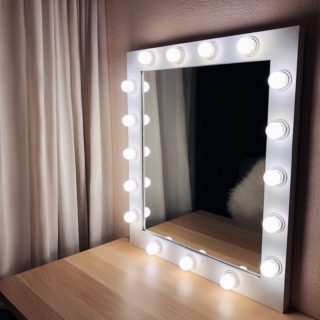
Illumination of the mirror is ordered by a master, made independently or bought a finished product. When choosing a ready-made option, take into account the style of the interior of the room, compatibility with pieces of furniture.
The functionality and aesthetics of the backlight are determined by the following parameters:
- The size and purpose of the mirror determine the number and location of light sources. A high canvas requires multi-level lighting, and for a compact one, it is enough to place two lamps on the sides.The exception is make-up rooms, make-up mirrors, the illumination of which consists of ten or more lamps, evenly distributed over the frame.
- Complete set of mirrors - additional accessories, shelves, built-in drawers, cabinets that need local lighting.
- Frame body materials, types of lighting fixtures. Plastic and metal frames are the most functional, as they are not affected by the external environment. Wooden structures have an aesthetic appearance, but they dry out or absorb moisture. The manufacture of such frames requires adherence to technology. Incandescent lamps are incompatible with wood, as they heat up to high temperatures, drying out the material.
Construction safety is a decisive selection criterion. Open mounts of cartridges, protruding contacts, protruding wires are not allowed.
Design and appearance
Lighting devices and the shape of accessories are selected based on the characteristics of the interior of the room. For modern design, mirrors of regular geometric shapes are suitable, and carved canvases are compatible with the classic style.
External lighting is mounted on a massive frame, the shape and color of which affects the appearance of the room. Transparent lamps are covered with diffusing shades. LED lamps with a matte bulb have an aesthetic appearance, which allows them to be used without special caps.
Built-in lighting is decorated with carved windows in a reflective coating, through which light enters. The reflective layer is carefully cut in the form of drawings, patterns, ornaments.
DIY installation and connection
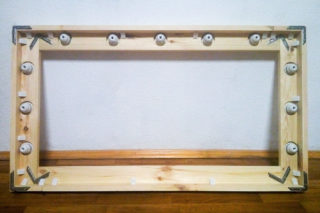
As an example, we will consider the process of making an external illumination of a 50 × 70 cm makeup mirror on a wooden frame of sixteen LED lamps with a standard E27 base, an operating voltage of 220 V. Lamps with matte caps, a luminous flux of 280 lm, a power consumption of 3.5 W will be used ... The assembly will require 16 ceramic cartridges, a cable, a button switch, a wooden block, plywood, metal corners, self-tapping screws, PVA glue.
Phased work plan:
- Frame manufacturing. Sawing a bar into 4 pieces with mirror side lengths and 45˚ cut corners. Frame assembly, gluing, fixing with corners.
- Marking, drilling holes with a diameter of 35 mm for cartridges. For the upper and lower platbands, 5 cm recede from the corner of the frame, 5 holes are drilled every 15 cm, observing the axis of symmetry. For lateral platbands, the outermost holes are placed 10 cm from the corners, as well as one hole in the middle. The result is 5 grooves on the horizontal sides of the frame, and 3 grooves on the vertical parts.
- Processing a baguette with sandpaper.
- Installation of cartridges, fixing on glue, corners, screws, parallel connection to an electric cable with a switch and a plug.
- Baguette painting, varnishing or staining.
- Installation of a mirror sheet.
- Fastening the plywood back cover.
- Installing lamps, checking by connecting to the network.
This design produces uniform illumination with a total luminous flux of 4480 lm, consumes 56 W of power, and does not heat up. Concealed installation of cartridges guarantees safe operation.
The equipment of a metal baguette with electrical wiring with a voltage of 220 V requires compliance with safety rules. The frame body is grounded and the cable is placed in insulated ducts or corrugations.
Interior solutions and tips for choosing for different rooms
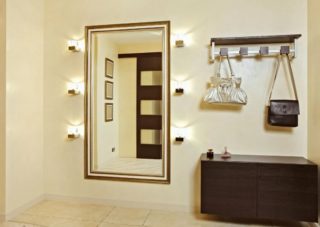
The entrance hall gives the first impression of the apartment, so pay due attention to its furnishings. Large mirrors visually expand the space. Installing seamless reflective panels throughout the wall will help balance narrow, long corridors. Zonal built-in LED lighting in the form of a geometric shape will decorate such an interior.
For a minimalist hallway, a tall mirror in a thin aluminum frame is suitable.A smooth strip of built-in LED-backlighting along the perimeter of the canvas will emphasize the modern design.
In hallways with a classic interior, mirrors with carved baguettes and decorative sconces are installed, evenly distributed along the sides of the frames. Lamps and moldings are stylized to resemble old antiques, which makes the interior presentable.
A make-up table with a stationary mirror is a convenient option for the bedroom. LED lighting on a massive carved wood molding creates a cozy, soothing atmosphere. A useful feature for the bedroom is dimmable.
A frameless wall mirror with a wide, built-in LED strip that surrounds the perimeter of the canvas will successfully fit into the modern interior of the bedroom. The presence of color changing and mode switching functions will turn such a mirror into a central decorative element.
Illumination of makeup mirrors is made from lamps emitting a white spectrum with a color temperature of 4000 K. This spectrum gives natural light.
Making your own mirror illumination is not difficult if you have basic skills. The balanced design will provide the correct lighting for the space, creating a realistic reflection.








